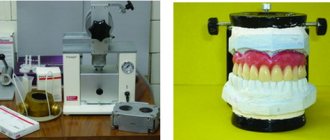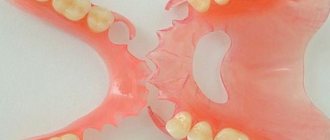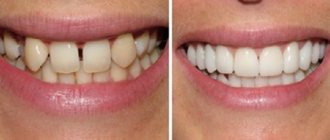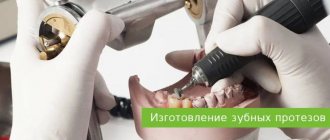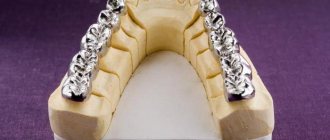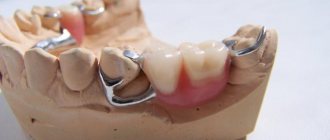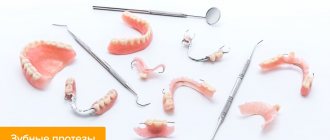The stages of making a clasp denture is a procedure that involves a professional and careful approach in dentistry. As a result of the step-by-step process, a product is obtained that successfully replaces implants and restores the dentition. The design is indicated for certain disorders and in the absence of natural units in the dentition. It is installed during the period of preparation for prosthetics to maintain aesthetics, correct deep bites, as well as for the treatment of periodontal disease and bruxism. Clasps have a number of advantages and, with proper care, last a long time. Modern orthopedic dentistry offers several types of clasps, for the manufacture of which special materials are used.
What is a clasp?
The clasp is a titanium, chromium-cobalt or gold-platinum frame in the shape of an arc with special fasteners. The main advantage of such dentures is their ability to rest not only on the gums, but also on the body of the jaw, palate, alveolar processes and healthy teeth.
Thanks to this design, the chewing load and pressure are evenly distributed over the entire dentition, preventing the process of loosening and premature loss of healthy teeth.
Nowadays, clasp prosthetics is becoming more and more in demand and popular.
This is due to a noticeable qualitative leap in the production of prosthetics. Modern clasps have a lightweight, durable, openwork design and practical fastenings that are invisible to prying eyes; they are durable, reliable and easy to use.
Main aspects of casting technology for clasp denture frames
The purpose of the work was to identify criteria for the selection of duplicating, fire-resistant and modeling materials at the stages of manufacturing cast structures of clasp dentures.
Key words: clasp prosthetics, duplication, casting, denture, model, frame, modification.
Introduction
Currently, clasp prosthetics are becoming increasingly popular, which is associated with a sharp qualitative leap in their production, due to the creation of new materials and technologies. Precision casting technology makes it possible to make the design of a clasp prosthesis functional and aesthetic. Casting precision is associated with many technological aspects, in particular with preparation for the casting stage of clasp denture frames.
A special approach requires duplicating the working model, making it from a refractory mass, modeling a wax prototype of the frame of a clasp denture, as well as constructing a gating system.
The purpose of the study was to identify criteria for the selection of duplicating, fire-resistant and modeling materials at the stages of manufacturing cast structures of clasp dentures.
Preparing a working model for duplication
The technology for manufacturing clasp dentures involves casting metal frames of dentures on fire-resistant models. To obtain fire-resistant models, a procedure for duplicating working models is required.
After a preliminary study and drawing of the working model in a parallelometer, as well as planning the design of the clasp prosthesis, we begin duplication [2].
Duplication is the process of obtaining an exact copy of a model using special impression compounds in a laboratory setting.
The amount of manipulation during this procedure depends on the type of denture [9]. So, for example, when using arched (clasp) prosthetics, the following preparatory steps are carried out:
1. The height of the base of the plaster model of the jaw is adjusted to 1.5 cm using a cutting tool, while the side surface of the base should be perpendicular to its base. If necessary, a portion of gypsum is used to isolate the pores and defects present in the base of the model;
2. Blocking with special pink wax:
A). The gingival margin and the deepest sections of the undercuts of the teeth, with the creation of steps on the supporting teeth under the clasp arm, which will make it possible to correctly position the wax clasp arms on the refractory model [10];
b). Tissue undercuts on the alveolar ridges. This is necessary for the smooth removal of the plaster model from the duplicating mass. The melting point of such wax maintains the temperature of the molten duplicating material. The wax is smoothed with an electric spatula or scraper. In addition to wax, you can use silicone impression material for this (without using catalyst paste or liquid). The accuracy of filling undercuts is checked using a parallelometer [10];
3. The contours of the frame of the arched (clasp) prosthesis are covered with clasp wax with a thickness of 0.3 to 1.0 mm.
If it is planned to duplicate a plaster model of the jaw using hydrocolloid masses, then such a model of the jaw is kept in water at a temperature of 38 °C for 15–20 minutes, after which it is dried with napkins [4]. The use of compressed air for this purpose leads to wax detachment in places of insulation.
Rice. 1. Model of the upper jaw, prepared for duplication
4. Fixing the prepared jaw model in a ditch for duplication:
The working model must be placed in the center of the high-strength rubber base of the cuvette, strengthened with soft wax or plate-like paste, which gives uniform thickness to the duplicating mass around the model. After fixing the model, an aluminum or polymer cuvette body is installed above it [9].
Rice. 2. Fixation of the prepared jaw model in a ditch for duplication
Duplication with hydrocolloid masses
Dental laboratories use hydrocolloid materials with different characteristics, but they are similar in technological qualities. Clasp dentures with clasp fixation are usually duplicated with hydrocolloid mass [5].
Rice. 3. Duplicating gel WiroGel M and Wirodouble
For duplication, a special apparatus is used to heat and maintain the temperature mass [1]. Maintaining temperature when working with hydrocolloid masses reduces the degree of their shrinkage, improving the result.
A characteristic feature of hydrocolloid masses is syneresis.
This process is accompanied by compaction of the spatial structural network due to the formation of additional contacts between particles or macromolecules. In this case, the volume of the hydrocolloid mass decreases and a liquid phase is released, which deteriorates the quality of the refractory material, from which we subsequently obtain a refractory model.
Hydrocolloid masses and requirements for them:
- The mass for the negative form must be thermoplastic, for repeated production of prints, have a low melting point (less than 100 °C) and have sufficient plasticity and elasticity [2];
- The mass must be poured into a ditch at a temperature of about 60 °C with good filling and accurately give a negative volume to the poured plaster model, repeating and maintaining the configuration of its volume and shape after its removal from the hardened mass [2];
- The hydrocolloid mass should not have a harmful chemical effect on both the plaster model and the refractory mass.
Advantages:
- Accurate reproduction of all the subtleties of the design on the model due to its fluidity;
- Good elasticity, the ability to fully return to its original state, if you are careful when removing the control model from the mold;
- Possibility of repeated use;
- Hydrocolloid masses are more economical in comparison with silicone masses [9].
Flaws:
- Sensitive to heat.
- Due to the high proportion of water, constant evaporation occurs.
- When using an open flame or electric stove to melt the duplicating mass, it must be melted in a water bath.
- The mass is not transparent at the moment of rupture. Using this mass it is impossible to obtain an exact duplicate.
- The water included in the composition affects the curing investment masses.
- When the still liquid mass is cooled from 50 °C to 8–10 °C in running tap water or in a special apparatus, shrinkage occurs.
- Low bacteriological resistance (formalin, antiseptics).
Duplication with silicone masses
Silicone duplicating masses are A-silicones. Two-component A-silicones are universal, they are elastic, non-shrinking materials. Their stability makes it possible to duplicate working models with a high degree of accuracy. Unlike molds made from gelin and alginate, silicone does not collapse when the duplicate is removed, and without loss of accuracy allows you to make several identical models using the same mold, even after a week or more [5].
An essential component is agar-agar, which, depending on the recipe, makes up 2–5% of the hydrocolloid mass [3]. Agar agar is made from red seaweed by boiling and adding acetic or sulfuric acid, filtering and cooling. As a result of complex processes, water is released and thin elastic plates of agar-agar are formed. They are dried, cut into strips and ground into powder. When cold, agar-agar is insoluble, but when heated it swells slightly and dissolves.
The hardness of silicones is usually measured on the Shore scale. Usually laboratory silicone is used 22 units. according to the Shore scale.
Advantages compared to hydrocolloid masses:
— very accurate reproduction of shapes and reliefs;
— the model does not need to be soaked;
- after about 45 minutes, starting from the moment of mixing, the negative form is ready for further work;
— it is possible to re-fill with gypsum to obtain a control model;
— there is no reaction between the mold material and the investment material.
The disadvantage of silicones is:
- high cost compared to hydrocolloid masses;
- Possibility of one-time use.
Refractory masses
A fireproof model is a model made of fireproof particles that are resistant to high temperatures.
Refractory masses are special investment materials. They are a mixture of refractory powder with a binder component [6].
Rice. 4. Investment material Wirovest, WiroFine, Wiroplus S
The composition of investment materials and the technologies for their use are different, but in any case they consist of the following components:
— fire-resistant particles;
— binders;
— technological additives.
In the manufacture of fire-resistant models, the powder + liquid system is used: powder; barrier fluid; water (sometimes).
Refractory powder is a finely dispersed material:
1) Silicon dioxide SiO2 (silica), which is usually presented in the modifications quartz and cristobalite or in the form of a mixture of these components.
2) Aluminum oxide Al2O3 (alumina) [11].
Silica is mainly used as a refractory powder. The starting material for the production of silica is quartz sand [12].
The composition of technological additives in most cases is a trade secret of the manufacturer. Additives are used to regulate the fluidity of the investment material in a liquid state, speed up or slow down the hardening time, to reduce the amount of foam and air bubbles during vacuuming, etc.
Depending on the binding component, molding materials are divided into three groups: gypsum (gypsum), silicate (silica gel), phosphate (zinc, aluminum or magnesium phosphates) [3].
Phosphate investment compounds are the most progressive investment material used in modern dental casting. They consist of a mixture of modifications of SiO2, a phosphate binder and additional components for clasps [19].
Fireproof models must be made of the same materials as the volume of the flask.
The binder is added in the form of ammonium dihydrogen phosphate (NH4H2PO4) and magnesium MgO. The mixing liquid consists mainly of water, phosphoric acid, catalyst and other components.
Packaging materials must meet the following requirements:
— To ensure a high-quality casting surface, the refractory powder must have high dispersion;
“They must create a gas-permeable shell that will be able to absorb the gases generated when pouring molten metal.
— They should not contain substances that, when reacting with the casting, reduce its quality.
— Ensure the strength and integrity of the casting mold, its gas permeability during casting.
— Possess the ability for thermal expansion, compensating for the shrinkage of the casting.
— Maintain temperatures not lower than 1700 °C.
Modeling materials in clasp prosthetics
Modeling materials are usually a mixture of waxes and other materials. Each wax mixture must meet certain requirements, taking into account the specifics of their application [1].
Waxes are fat-like amorphous substances with a melting point of 40–90 °C. In terms of chemical composition, these are higher saturated fatty hydrocarbons, their monohydric alcohols and esters of higher essential acids.
Requirements:
1) Use dental waxes strictly for their intended purpose, preferably from the same manufacturer;
2) Modeling polymers can be self-hardening or light-curing;
3) Must be ashless.
Rice. 5. Clasp wax
Clasp wax must have a strictly fixed thickness, allowing you to create the necessary, uniform gaps in a given area, ensuring the correct location of the frame of the finished prosthesis in the oral cavity. Available in the form of disks with a diameter of 82 mm, a thickness of 0.4 and 0.55 mm [3].
It is used for spacers on models in the manufacture of clasp dentures and as a modeling tool in the manufacture of solid and combined bases in removable lamellar dentures [7].
Rice. 6. Profile waxes
Profile waxes , meeting the above requirements, are used to model the frames of clasp dentures. Supplied in the form of rods of several diameters, which soften based on the temperature of your hands. Voskolit-1, green in color, is used for the manufacture of a gating system. Voskolit-2, blue or pink, is used for casting outside the model and Voskolit-03 for modeling frames of clasp dentures [3].
Rice. 7. Formodent set
The Formodent kit includes a silicone plate with recesses for obtaining wax blanks of individual elements of the clasp prosthesis; a briquette of green or light brown wax for casting with an insignificant ash residue [17].
Gating system
The gating system plays an important role in ensuring the quality of the casting of the clasp prosthesis frame. During the casting process, it is necessary to obtain a smooth, pore-free surface of the frame, which is well polished and remains shiny when the patient cares for the prosthesis. Precision casting ensures the preservation of the spring properties of the clasps necessary for fixing the clasp prosthesis [2].
The sprues are channels through which molten metal enters the mold, with a diameter of at least 2–3 mm. Depot for metal with a diameter of 1.5–2 mm. At two levels at the frame and at the sprue bowl, but if the sprue is thick (3–4 mm) and short, the coupling may be missing [21].
The number of sprues and their location depends on:
— casting methods;
- melting methods;
— frame dimensions;
— complexity of the frame configuration;
— distance from the supply cone.
The size and shape of the gating system depends on the method of melting and pouring the metal. If melting is carried out in a sprue bowl, then the diameter of the sprue does not exceed 1.5 mm; if centrifugal pouring is used when melting metal, then the sprue must be thick (it plays the role of a feeder - profit) [18].
The shape of the sprues:
Rice. 8. Cross-shaped impeller, single-channel
1) Cross - openwork casting of the tire is used. Possibly flat sprues 0.5×1.6;
2) Impeller - (according to Osborne) round gates with a diameter of 3–4 mm are arranged in an arcuate manner;
3) Single-channel sprue - centrifugal or vacuum casting. The 4–6 mm sprue narrows before touching the frame and widens at the sprue part; there are no couplings [20].
The flask can contain 2 frames; usually the models are installed on the distal surfaces.
When modeling a wax structure on the upper jaw and due to the large number of wide and additional elements on its arch, casting channels should be installed as flat as possible and the casting of the frame should be done “from above” to avoid deformation; on the lower jaw, casting can be done from above and through the model [ 8].
Alloys used in orthopedic dentistry can be divided into three groups depending on their melting point:
- Alloys with a melting point of up to 300 °C (low-melting alloys based on tin);
- Alloys with a melting point of up to 1100 °C (gold-based alloys);
- Alloys with a melting point above 1200 °C (stainless steel, KHS, etc.) [14].
Melting of alloys of the first group is carried out in a metal ladle over the flame of an alcohol lamp or gas burner. Melting alloys of the second and third groups requires special equipment (high-frequency furnace), which allows one to reach high temperatures [4].
The infrared temperature control system, which is equipped with most modern foundry machines, maintains a temperature close to the melting point of the alloy and thereby ensures uniform heating of the workpiece. After installing the heated crucible, the infrared system switches to the maximum temperature. Casting temperature is reached within a few seconds. This ensures an extremely short time before casting.
Casting metal alloys is a complex process using high-tech equipment - muffle furnaces and foundry installations.
In order for the metal to fill the mold cavity formed after melting the wax, pressure must be created on the metal [17]. Depending on the nature of the resulting pressure on the metal, the following methods of pouring metal into molds are distinguished:
- Free pouring - metal fills the mold freely under the influence of gravitational forces;
- Pouring into a rotating mold under the influence of gravitational and centrifugal forces;
- Pouring by pressure, piston or air, using foundry installations;
- Filling with vacuum suction.
Injection casting and centrifugal casting are based on applying external pressure to the metal. This casting produces denser castings [1]. During vacuum casting, the alloy flows into the mold cavity under the force of gravity of its own weight, eliminating porosity, underfilling and shrinkage cavities.
Conclusion
The final result of restoring the functionality of the dentition and the entire dental system as a whole depends on the fulfillment of the criteria for each technological stage of prosthesis manufacturing. The correct selection of a set of materials also affects the final result.
The precision of the metal frames of clasp dentures depends on the quality of the preparatory procedures.
The best results can be achieved using silicone duplicating compounds, phosphate refractory compounds, and modeling casting waxes of a single system. Today the leading manufacturer of this system is BEGO.
It is also important to carry out the casting stage itself. The BEGO system offers special metal alloys and even casting machines to guarantee the precision of the partial denture frames.
Literature:
- Kulazhenko V.I. et al. Clasp prosthetics. - K.: Health, 1975. - 104 p.
- Mironova M. L. Removable dentures: Textbook. - M.: GEOTAR-Media, 2014. - 464 p.
- Smirnov B. A. et al. Dental engineering in dentistry: Educational manual. - M.: GEOTAR-Media, 2014. - 336 p.
- Trezubov V.N. et al. Orthopedic dentistry. Technology of therapeutic and preventive devices: Textbook for medical universities. - M.: MEDpress-inform, 2014. - 320 p.
- BEGO Training Center // Clasp prosthetics technique. - 2012. - No. 3. - p. 8–9.
- BEGO Training Center // Clasp prosthetics technique. - 2012. - No. 3. - p. eleven.
- BEGO Training Center // Clasp prosthetics technique. - 2012. - No. 3. - p. 12–13.
- BEGO Training Center // Clasp prosthetics technique. - 2012. - No. 3. - p. 15.
- Duplication of the plaster model [Electronic resource]. — Access mode: https://dentaltechnic.info/index.php/byugelnye-protezy/byugelnoeprotezirovanie/1053-dublirovanie_gipsovoj_modeli (access date: 06/08/2016).
- Duplication of plaster models of jaws [Electronic resource]. — Access mode: https://medlec.org/lek-78783.html (access date: 06/08/2016).
- Manufacturing of clasp dentures from modern materials [Electronic resource]. — Access mode: https://www.zubtech.ru/article200305a2.php (access date: 06/08/2016).
- Making a fireproof model [Electronic resource]. — Access mode: https://dentaltechnic.info/index.php/byugelnye-protezy/byugelnoeprotezirovanie/1054-izgotovlenie_ogneupornoj_modeli (access date: 06/08/2016).
- Frame of a clasp prosthesis [Electronic resource]. — Access mode: https://dentaltechnic.info/index.php/obshie-voprosy/rukovodstvodlyazubnyhtehnikov/821-karkas_byugel_nogo_proteza_ (access date: 06/08/2016).
- Materials science in dentistry [Electronic resource]. — Access mode: https://medbe.ru/materials/stomatologicheskoe-materialovedenie/?PAGEN_3=3 (access date: 06/08/2016).
- Modeling the frame of a clasp prosthesis [Electronic resource]. — Access mode: https://neostom.ru/protezirovanie-biugelnimi-protezami/modelirovanie-karkasa-biugelnogo-proteza.html (access date: 06/08/2016).
- Modeling the frame of a clasp prosthesis [Electronic resource]. — Access mode: https://stomatolog-umsa.poltava.ua/kafedra/metodicheskie_razrabotki_dlya_samostoyatelnoy_roboti_3-go_kursa_modul_2/modelirovanie_karkasa_byugelnogo_proteza.html (access date: 06/08/2016).
- Frame modeling and gating system installation [Electronic resource]. — Access mode: https://medlec.org/lek-138813.html (access date: 06/08/2016).
- General principles of creating a gating system [Electronic resource]. — Access mode: https://ucheba.medgum.ru/EOR/Zub-teh/liteinoe_delo/04.htm (access date: 06/08/2016).
- Refractory and molding materials [Electronic resource]. — Access mode: https://medlec.org/lek-132190.html (access date: 06/08/2016).
- Creation of a gating system [Electronic resource]. — Access mode: https://neostom.ru/protezirovanie-biugelnimi-protezami/sozdanie-litnikovoy-sistemi.html (access date: 06/08/2016).
Structure and types of clasp dentures
A standard clasp prosthesis consists of a durable frame equipped with supporting, retaining and unloading elements:
- arc;
- fastenings;
- base with artificial plastic or porcelain teeth.
Depending on the type of fastenings, the following types of clasp dentures are distinguished:
- clasp (the device is held in the mouth thanks to special hooks that tightly cover the supporting teeth);
- locking (prostheses are attached to metal-ceramic crowns placed on abutment teeth);
- with a telescopic fixation system (to secure the prosthesis, two interlocking crowns are used, one of them is located on the device itself, and the second is attached to the abutment tooth).
Clasp
Castle
Technique for casting prosthetic structures
Cast dental bridges, single-tooth metal crowns and partial dentures are made using lost wax casting. Since cast dentures have been used for a long time, many techniques and rules have been developed that allow such structures to be performed with the highest quality. Several factors play an important role in this process. One of the primary ones is the choice of investment material. Today they can be phosphate, silicone and gypsum-based. Regardless of which type of forging material the dental technician chooses for oral treatment, they have a number of common characteristics:
- Stable thick consistency;
- Long working hours;
- Good mixability;
Stable expansion rates during heat treatment. All investments are mixed only in vacuum mixers. This is done in order to prevent the formation of air bubbles, which expand when heated and lead to inaccurate dental prostheses. Therefore, it is important to choose a high-quality device for mixing material under vacuum.
In addition, the intensity of mixing the material plays an important role in the manufacture of dentures. Modern materials allow vibration to be applied only before the wax surface is introduced. Then the vibration turns off. This avoids the formation of voids and cracking of the prosthetic structure for the teeth.
The choice of material from which cast fixed dentures will be made is important for the reason that the durability of the products and their comfort in wearing and antiseptic properties depend on it. Before installing dentures in your mouth, you need to discuss these nuances with your dentist and dental technician. After this, a bridge or other prosthetic structure for the teeth is cast. At the request of the patient, the cast denture can be lined with ceramic or plastic material.
Thus, the work of dental technicians in the manufacture of such prosthetic structures for teeth requires the use of a large amount of medical equipment and various high-tech materials.
Stages of clasp prosthetics
Preparation of prosthetics
Preparation for clasp prosthetics begins with an examination of the patient. Doctors carefully listen to the patient’s complaints and wishes, conduct a dental examination, and study the patient’s medical history. After this, after analyzing the results of the examination, dentists decide on the need for clasp prosthetics.
Treatment of dental diseases
Before the production of the prosthesis begins, teeth that cannot be preserved are removed, periodontal disease and other dental diseases are treated. If there is a pronounced inclination of the abutment tooth or if there are restorations on it, as well as with prosthetics using telescopic or locking fixation, crowns are put on the abutment teeth.
Indications
Clasp dentures with clasp fixation are recommended in the following cases:
- In the presence of a terminal defect of the teeth.
- Missing one or more teeth.
- For splinting in case of periodontitis or periodontal disease.
- The presence of deep bite and bruxism, if other methods of prosthetics are contraindicated.
- For orthopedic treatment in cases of increased tooth abrasion.
- Atrophic process of the alveolar process, if it is impossible to use a plate structure.
- The presence of a flat palate and pronounced maxillary tuberosities.
- Diabetes mellitus and other diseases in which weakness of the capillaries of the oral mucosa is expressed.
Making a prosthesis
All video presentations
Taking an impression
The production of a clasp prosthesis begins with taking a diagnostic impression. This impression is used to create a working model, which the dental technician is guided by when making the frame.
Production of clasps
The most critical stage of work is the production of clasps or crowns with fasteners. The clasps must accurately follow the shape of the patient’s supporting teeth and tightly cover them without damaging the enamel. In turn, the crowns with the mating parts of the locks must completely correspond to the clasp itself with the lock. Precision in the production of fasteners is a guarantee of the durability of the prosthesis and ease of use.
Casting the prosthesis frame
Having completed work on the manufacture of fasteners, the dental technician sketches the frame of the prosthesis and duplicates the working cast, that is, creates a fire-resistant master model. Then the sketch of the future clasp is transferred to a fireproof cast, and casting channels and a flask are installed on it. Gold-platinum, titanium or cobalt-chromium alloys are used to cast the frame.
Installation of artificial teeth and fitting
The finished frame is polished, support-retaining and unloading elements are attached to it, and it is tried on in the patient’s growth cavity. After this, artificial teeth matching the color are installed on the base and re-fitting is performed. On average, the production of a prosthesis takes 2 months.
Service life and how to care
On average, the service life of a clasp prosthesis is 2–3 times longer than that of a conventional plate prosthesis. This is achieved through more advanced production technology and high-quality raw materials.
With good care - daily at home and regular professional hygienic cleaning in dentistry - your new teeth will last from 5 to 7 years. On implants – up to 10 years due to the absence of resorption, play and displacement during chewing.
Caring for clasp dentures
Every day, twice a day at least, and ideally after every meal, you need to brush your teeth. If the denture is removable, remove it and wash it with soap or toothpaste, thoroughly cleaning the surfaces with a brush. Rinse with boiled or purified water.
Once a day, disinfection should be carried out by dipping the prosthesis in a disinfectant solution for 5–10 minutes. For its preparation, special water-soluble tablets are used. Once a week you can soak it for a longer period in a bio-solution for better cleaning.
Using this method, all biological debris, including pieces of food and plaque, are removed from the prosthetic surface. After disinfection, the product is washed with boiled water and is ready for storage in a case or use. Dentists strongly do not recommend leaving the prosthesis in storage for a long time, especially if it has a splinting effect.
You should make an appointment for professional cleaning at least twice a year. In this case, the denture workshop cleans the polymer and metal parts, as well as calibrates them to fit the patient’s jaw.
Careful care, timely repairs and relining extend the life of the product, allowing you to avoid its breakage due to the gingival contour changing over time and the associated improper load distribution.
Advantages and disadvantages of using clasp dentures
Benefits of prosthetics
The main advantages and advantages of clasp prosthetics are:
- durability, reliability and strength of prostheses;
- tenacity of fastening the clasp in the oral cavity;
- the ability to perform prosthetics even if there are only a few teeth in the dentition;
- ease of care for the prosthesis;
- the ability not to remove the clasp at night;
- no discomfort, impaired diction, or inconvenience when eating.
Special clasp-type prosthetic structures
Clasp prosthesis Quadrotti
Produced using the unique patented Quattro Ti technology since 1986. The prosthesis is based on a thermopolymer (nylon-based plastic). There is no metal. Thanks to this, the prosthesis has many advantages:
- hypoallergenic;
- highest aesthetics;
- chemical inertness;
- short adaptation period;
- complete biocompatibility;
- no gum irritation;
- installation without tooth preparation.
Attention. Due to the flexibility of the design, its significant advantage is that it can be used by those who engage in boxing, wrestling and other traumatic sports, as well as those who work in harmful and dangerous industries.
Comfort of wearing is ensured by high adhesion to the surface of the prosthetic bed, elastic material, and soft clasps. Due to the lack of possibility of relining, such prostheses must be changed once every 3–3.5 years.
Quattro Ti manufacturing features
The Quadrotti prosthesis is made in a dental laboratory individually for each patient using the thermocasting method. For these purposes, special equipment and raw materials are used, from which the future prosthesis is formed based on the impression and model of the jaw.
The manufacturing technology is worked out to the smallest detail, so butterfly prostheses and larger thermoplastic structures wear well. Their invisibility on the teeth is ensured by the presence of several shades of raw materials.
White plastic is used inside and for hooks (clasps), and red plastic is used to make the gingival part. It practically blends with the color of the oral mucosa, so the structure on the teeth is not only not felt, but also invisible.
Care for Quattro Ti prostheses should be more gentle. They need to be cleaned with a soft brush and a special paste designed for elastic plastics. Periodic disinfection with a special disinfectant solution is recommended. For details, please contact your dentist at our clinic.
Splinting clasp dentures
In case of increased instability of the supporting teeth and the presence of a defect in the dentition, it is recommended to install dentures, the design of which contains special elements (processes, clasps). With their help, the prosthesis tightly covers the crowns of the teeth, which avoids further loosening.
The indication for wearing a splinting prosthesis is not only degree II-III tooth mobility, but also a pathological deep bite along with increased abrasion of the tooth surface.
Its distinctive feature is the presence of individual hooks on the teeth or an entire arch running along the inner surface of the dentition.
The advantage of this design is the uniform distribution of the load throughout the jaw, rather than concentrating it on just the supporting teeth. It is also worth additionally noting such an important plus as light weight.
Material used
The main material for the manufacture of the arch of clasp prosthetic structures is chromium-cobalt alloy. The arc of fastening of prosthetic structures with locks includes metal-ceramic crowns. A more expensive, and therefore less common, option is to use gold-platinum alloy instead of chromium-cobalt alloy, which does not cause allergies. In addition, there are metal-free clasp dentures, which use ceramics or extremely durable pressed plastic to make the arch. They are intended for patients suffering from metal allergies. These dentures are more fragile than metal ones, so they are at greater risk of damage and have a shorter lifespan.
Reviews
The presented type of prosthetics, although considered partly democratic, still remains inaccessible to most patients.
However, this is the best offer that dentistry can recommend today for the stated price. Prosthetics with clasp products are reliable, safe and durable.
You can leave your feedback on the prosthetic technique in the comments to this article.
If you find an error, please select a piece of text and press Ctrl+Enter.
Tags clasp dentures removable dentures
Did you like the article? stay tuned
Previous article
What is unique about Korean Anyridge implants?
Next article
What to do if a splinter remains after tooth extraction
Purpose of structures
The color and shape of clasp products meet high aesthetic requirements. They help eliminate lingering defects in various parts of the jaw row.
The prosthesis, equipped with locks and attachments, has a one-piece frame with an acrylic base. This design makes it possible to achieve high strength values of the base, so there is no need to create a massive base, which means that the frame and artificial gum will be light in weight.
This makes clasp prosthetics optimal for a patient with partial edentia.
A removable orthopedic device is used as a more advanced alternative to partial plate prosthetics in cases where, due to a complex clinical picture, it is impossible to produce a permanent dental bridge.
Clasp systems are prescribed in a number of clinical cases:
- double-sided end defect (there are no posterior specimens that could become a support for the bridge);
- terminal flaw on one side of the dentition;
- absence of more than 4 copies in the anterior section;
- absence of more than 3 units in the posterior part of the chewing row;
- diseases of the periodontal tissues in combination with problems with the integrity of the dentition;
- multiple pathological changes in the jaw rows;
- severe loose teeth.
Advantages
Clasp prosthetics with clasps has the following advantages:
- Comfort and functionality.
- Thanks to the uniform distribution of the chewing load, the development of pathological changes in the oral cavity slows down.
- Taste and temperature sensitivity is not impaired.
- No influence on diction.
- Quick adaptation to the design.
- Ease of use and care.
- Able to strengthen loose teeth.
- Securely fixed.
- Low cost compared to other types of removable prosthetics.
